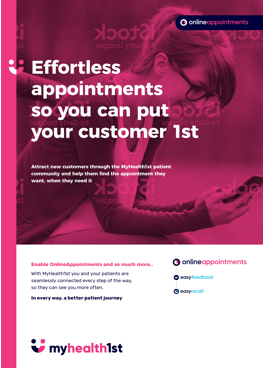
AHPRA (the Australian Healthcare Practitioner Regulatory Agency) has strict guidelines when it comes to reviews for medical practices and professionals. Selective editing of reviews is strictly prohibited, as is using a review in marketing or advertising.
Sites not controlled by the practice or practitioner can host reviews - what that means in essence is that third party sites like Google My Business can host reviews for your practice, but you can’t have them on your own website or Facebook page.
Google is the world’s most popular search engine by a mile, accounting for around 70% of all search traffic. Bing runs a distant second and Chinese search engine Baidu comes in a distant third. In an effort to streamline the search experience and offer more value to users and businesses alike, Google makes it very simple to find and read reviews of businesses.
Google My Business features easily accessible information of a business, including reviews, giving an aggregated star rating. According to research conducted by BrightLocal.com, 91% of potential customers (or patients in the case of medical practices) read reviews before dividing to make a booking or purchase. The same research showed that around 84% of people trusted online reviews roughly as much as a personal recommendation from a friend, and that 54% of people are likely to visit a business website after reading a positive review.
Ensuring that your practice has a number of positive reviews, both to help drive patients to your practice, and to lessen the impact of any negative reviews is a vital tool for driving new patients to your door.
Prior to asking for reviews, identifying who to ask, who should be doing the asking and how you should ask can help increase your chances of convincing patients to leave positive reviews.
Who Should I Ask for Reviews?
Before you start asking for reviews, it’s important to identify who you should ask. Identifying patients who have visited your practice a number of times is an important first step. Returning patients are far more likely to be willing to write a review, and are also more likely to have a positive outlook - they have visited the practice a number of times after all.
Who Should Ask for Reviews?
If you’re directly asking for reviews, the person who should be asking can change from case to case. Some people may have more rapport with their doctor, whilst others may be chatty with front desk staff or a nurse. Identifying these relationships can help when it comes to requesting reviews.
How Should I Ask for Reviews?
There are many approaches you can take to ask for reviews. Options include:
- Be Direct - ask a patient for a review. Being direct can be a very effective approach, but to maximise the effectiveness, making the process easy is important. Send a link to the review page directly to the patient via email or SMS after you’ve asked for a review acts both as a reminder and makes the process easy.
- Send Personalised Emails - After you’ve identified patients you think are likely to write a positive review, emailing them with a personal message thanking them for their business and trust. Personalised messages add a human touch to your practice and can help reinforce patient rapport and loyalty. THe messages don’t need to be long, but should contain a link to a review site or page, and instructions on how to post a review if the process is complicated.
- Send Bulk Messages - Though not as directed as individualised emails, a bulk email or SMS campaign targeted at the patients you have identified as being likely to leave a positive review. A simple message with a request for a review can prompt people to leave a review, especially if they have been asked in person previously. EasyRecall is an easy and effective way to create bulk email or SMS campaigns as well as see the effectiveness of a campaign in real time, allowing you to adjust your messaging.
- Set Goals - Setting a positive review goal can help motivate practitioners and staff to approach patients for reviews. Having a monthly goal gives everyone a target to shoot for.
Dealing With Negative Reviews
It’s all but inevitable that a practice will receive a bad review at some stage Often these reviews are due to factors such as wait times or other factors that may be beyond the control of a practice due to emergencies, consults being more complex than they initially appeared and the like.
Check the Post
Before making any decision on a review, check to see if the person leaving the review is a current or former patient. If they do not appear in your records or bookings then you may have a case to have the review removed. SImply writing a message underneath stating that the person is not and never has been a patient can also help assuage the worries of potential patients.
Removing posts
With most review sites, having reviews removed is all but impossible unless the review itself breaches the site’s TOS (Terms of Service), is erroneous or inflammatory. Even if the review is written on your own site, removing a negative review can be as harmful as having one up, as the practice can then be accused of censoring negative comments.
If the review breaches TOS or is erroneous in some way, approaching the reviews site with proof of the wrongdoing can help speed the process of having a review removed. Google has specific advice on how to approach legal violations and inflammatory posts. Just remember that if you’re trying to remove a review, the burden of proof is on you.
Contact the Reviewer
A far better approach than simply removing reviews, is to see if you can convince the disgruntled patient to remove or edit the review themselves. Talking through the problem with a patient that has left a negative review shows them that you care about the problems and are looking at ways to rectify that problem.
If you’ve received a number of negative reviews stating a similar complaint, using this feedback to improve that area of your practice (wait times, rude staff, etc) is a good way to get ahead of these problems and stop more negative reviews in the future.
Sometimes a negative review may be placed in error - someone giving a positive review in text but accidentally clicking the wrong star rating, or leaving a review on the wrong practice. Contacting these people and explaining the problem can turn a negative into a positive.
Having a positive review is just one of the ways you can help grow your practice. MyHealth1st is dedicated to helping practices and patients connect so they can get the help they need and you can concentrate on their health journey. To find out more about how MyHealth1st can help your practice grow and thrive, click here.
